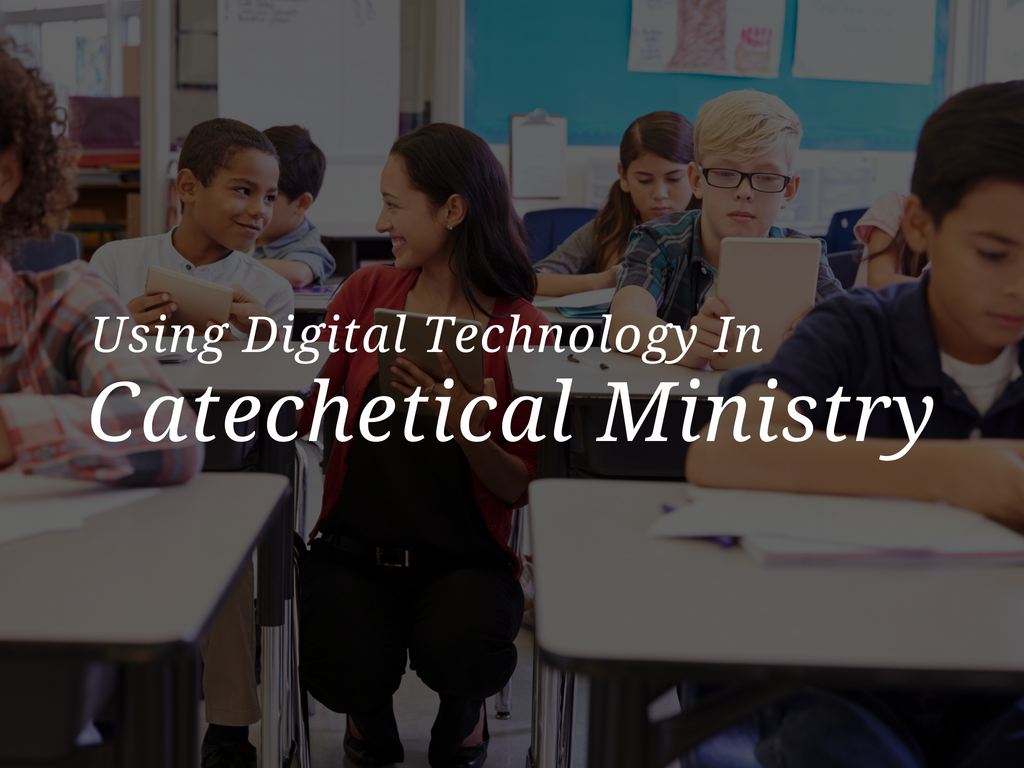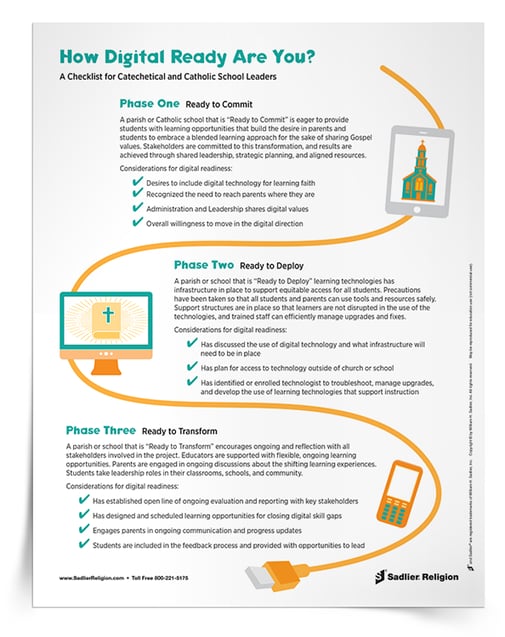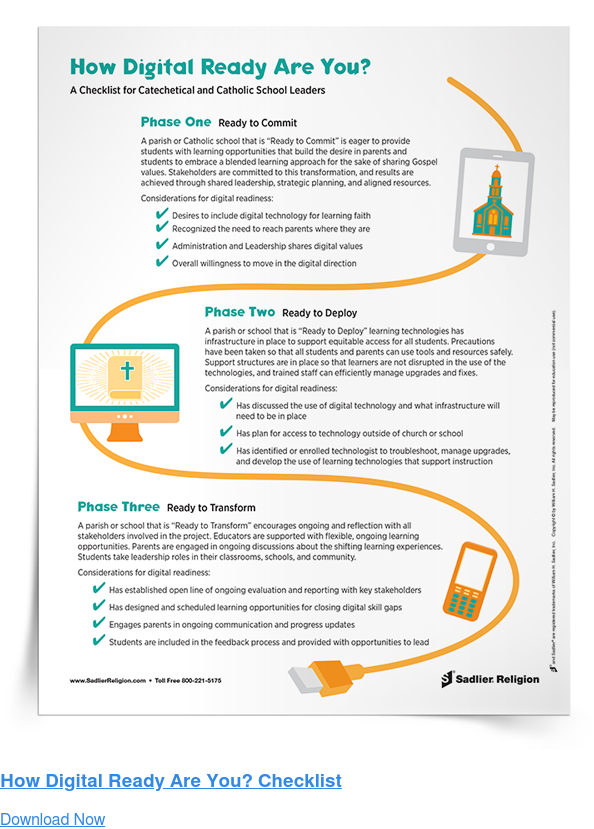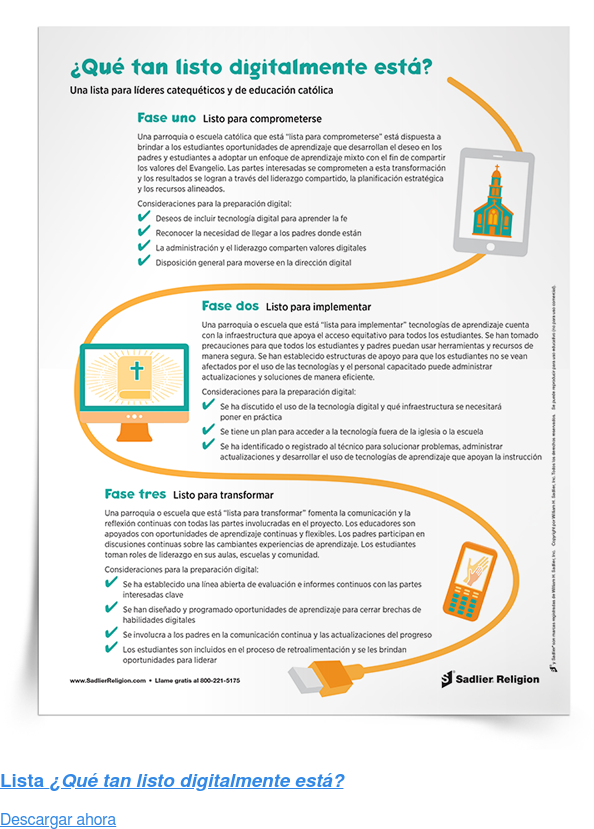June 12, 2018 WBAS Cat Support Articles, REL Topic- Blended Learning, REL Asset - Handout, REL PD - Leaders
Digital Technology in Catechetical Ministry – Guide for Catechetical and School Leaders
By: Guest Blogger
In this article, Steve Botsford, offers a look at the benefits and challenges of digital technology and its application to catechesis and religious formation. Download available in English and Spanish.
Download the How Digital Ready Are You? Checklist now.

As you read this article, reflect on the following questions:
-
What reservations do you have about the use of digital technology in catechetical ministry?
-
What steps might you take to become more digital ready?
-
Is your parish or school committed to include digital technology in faith formation?
OVERCOMING CONCERNS ABOUT USING TECHNOLOGY FOR CATECHESIS
It was almost time for students to arrive and I was getting very nervous. I had come early to make sure all of the technology was hooked up and working properly but the internet wasn’t connecting, so I couldn’t cue the lesson video or access the online game I spent an hour or two creating. These were to be the two hallmark technology pieces I hoped would engage our class. Fortunately, our parish has a couple of portable wi-fi routers, so I grabbed one and got connected in the nick of time!
This is but one example of the most common challenges we face using technology for catechesis. Perhaps you have faced something similar. In fact, there are many aspects of technology that can cause us great concern and fear.
Concerns That Keep Leadership from Supporting Digital Initiatives in Catechetical Ministry
Let’s take a moment to address some common concerns of those who may fear the use of technology for catechesis.
There are some who may have “tried” digital initiatives but may feel they were ineffective. These DREs or catechists could have ordered eBooks or assessments that went unused or tried apps or EdTech resources without much determined success. Some may feel we are simply over-saturated with technology and believe that face-to-face lessons with paper-based resources are more pure, wholesome, or effective. In addition, others may believe that we are going down the wrong path by supporting digital technology in catechetical settings.
The Case for Supporting Digital Initiatives in Catechetical Ministry
Consider that for over two decades computers have been commonplace at work and in the home. Laptops and desktops continue to sell about 150 million each year (1). Also, recall that the first consumer smartphone, the iPhone, made its debut in 1997, sold about 10 million units per quarter in 2010 and sold over 78 million in the first quarter of 2017 (2). Next, the iPad was introduced in late 2010 and sales were at over 9 million sold so far this year (3). I could go on with statistics, but believe you get the point; digital technology is here to stay!
What all of this means is that today every child that comes to us was raised with digital technology. How many times do we as adults turn to a child to teach us how to use the technology we hold in our hands?
We can all benefit from developing skills using digital technologies. You may be familiar with the common terms Digital Residents and Digital Visitors (4). Digital Residents are the children who have grown up with technology and use technology as their primary language. They think and feel by using technology first. Digital Visitors refers to adults who have become interested in technology but tend to turn to traditional means for information first and technology second. Today’s students have been socialized and educated differently than today’s adults.

HOW TO EMBRACE DIGITAL TECHNOLOGIES & USE THEM APPROPRIATELY IN RELIGIOUS EDUCATION
The implications of digital technology can be staggering. As catechists and educators, we have the responsibility to recognize the changes in technological developments and respond accordingly. The challenge we face is to embrace digital technologies and use them when and where appropriate. This conundrum is arguably the greatest challenge we face in religious education today!
Look to the Examples of Our Popes
In 2005, Pope John Paul II encouraged the faithful: “Do not be afraid of new technologies! These rank ‘among the marvelous things’ … which God has placed at our disposal to discover, to use and to make known the truth, also the truth about our dignity and about our destiny as his children, heirs of his eternal Kingdom.” (4)
Consistent with this advice, Pope Francis personally connects with people around the world through Twitter. A recent report states that his @Pontifex Twitter accounts have reached more than 40 million followers. Pope Francis realizes, however, it’s not about the technology but the person behind the technology. “It is a network not of wires but of people” (5).
The words of Pope John Paul II and the example of Pope Francis clearly show us that technology is an avenue to promote the faith.
Making Digital Disciples
In our call to engage students and remain relevant as a Church, we must act accordingly. Considering our call to promote the New Evangelization and create Missionary Disciples, should we not also be making digital disciples?
As educators of faith, we have an opportunity to safely and effectively use technology, which itself is not dangerous (6). We have an obligation to educate students using digital technologies, so they can become more intentional about using them for the sake of the Kingdom. We also have a responsibility to ministers to show how a blended approach of print and technology can be truly beneficial. We can help them understand that some digital approaches are effective and resonate well with students and parents. In a landscape of digital technologies how can we leverage digital technologies for the sake of promoting Gospel values?
Communicating with Parents and Families
Churches and schools can use technology for communicating with parents. Websites are the mainstay now for every parish and school. In fact, almost every church and school now have an online presence! Social Media has also become commonplace in today’s world. Connecting with parents and families today demands that we are reaching them how they want to be reached. Digital technologies are known to provide an abundance of opportunities to enhance instruction and engage learners. There is, however, great opportunity for growth in these areas for both schools and parishes. One of the most challenging aspects of doing so is learning how to use digital technology and what technology to use – all for the sake of deeper learning. Effective engagement will take place when these technologies and methods are embedded within our curriculum and leaders know how to use them.
IN SUMMARY
Today’s educators are in the midst of a digital skills gap – simply put, schools and parishes are experiencing a lack of qualified personnel necessary to inform, inspire, and provide support those who know little or nothing about digital possibilities. It is because of this skills gap, among other variables, that action needs to be taken now for three very important reasons: relevancy, engagement, and survival, all in a rapidly-changing world. What role do you play in the new digital landscape, and how digital ready are you?
MAKING CONNECTIONS
-
PARISH CATECHETICAL LEADERS– What new ideas did this article spark in you when it comes to using digital resources within your catechetical program?
-
CATHOLIC SCHOOL LEADERS– In what ways might you coordinate efforts to improve upon digital resources and provide the impetus to teachers to use it creatively?
RESOURCE IDEAS
-
Download a checklist of general considerations for digital readiness and share it with your catechists and teachers.




